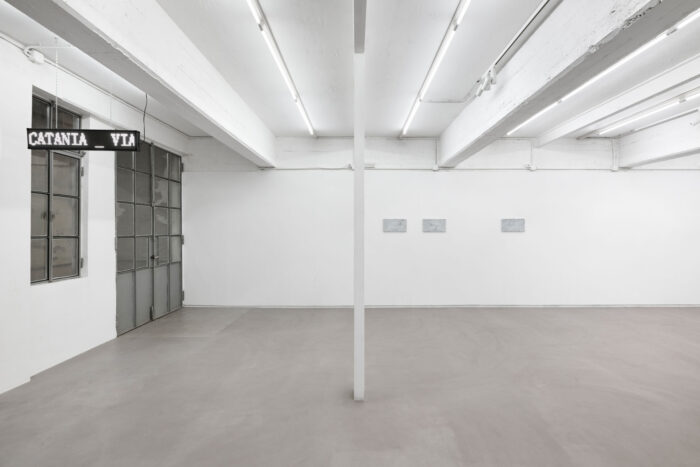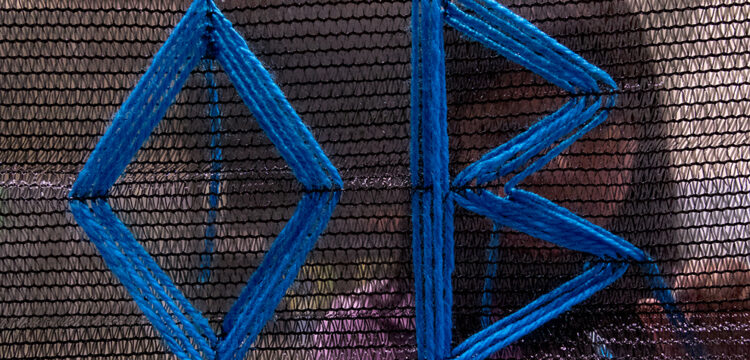A Phantasmagoric Journey
Through “Cose Bizzarre”: a conversation with Jermay Michael Gabriel
Curated by Elisa Giuliano, Cose Bizzarre marks the first solo exhibition in Italy of Jermay Michael Gabriel (Addis Ababa, 1997) at ArtNoble Gallery. Gabriel is a transdisciplinary Italo-Ethiopian Eritrean artist whose practice revolves around “an experimental, often radical, effort to resist the permanence and elusiveness of the Italian colonial archive, subverting its symbols of power.” The exhibition features a series of new works created between 2023 and 2024, mapping a “phantasmagorical journey” through the exploration and manipulation of key dualities: absence and presence, form and transformation, making and being made.
When I spoke with Jermay he was on his way to Toronto, where he spent nearly a month working.
Jermay Michael Gabriel: “People often focus on my curatorial practice, but please, in this interview, let’s only talk about my artistic practice,” he asked with a smile, as if he had clarified this many times before.
“The word bizzarre doesn’t have a clear etymology,” he explained. “The double z suggests a connection to Arabic. I chose it because it was widely used in the communications of the Istituto Luce, associated with Ethiopian, Eritrean, and Somali natives and ‘their fantasies,’ costumes, dances, and food. These were referred to as cose bizzarre, tied to a magical and ritualistic world, an unknown reality far removed from the West. It’s a term that immediately creates a sense of distance from the ‘other’—the language of the civilizer.”
Upon entering ArtNoble Gallery, the lively hum of voices attending the opening reception fills the space. A digital lightbox reminiscent of a bus stop sign hangs from the ceiling and immediately catches my eye. It displays street names that don’t exist. The artwork, titled Italy Sightseeing (2023), traces an imagined bus route starting in Catania and ending in Milan, with the final stop at ArtNoble Gallery. Along the route, the bus makes stops at various streets, including Via Assab, named after the bay that marked the beginning of Italian colonialism in 1882; a fictional itinerary that highlights the symbolic role of street names in shaping and perpetuating colonial memory.

The exhibition itself unfolds as a series of imagined stops tied to real historical narratives, blending sarcasm and somber reflection. By manipulating and reframing these histories, the works alternately obscure and expose hidden memories, prompting the audience to engage in an active dialogue with the past. Along the gallery’s wall, three marble slabs are engraved with street names: Via Dogali, Via Adwa, and Via Ambara.
Jermay: “Via Adwa references the Battle of Adwa in 1896, the first major defeat of a European power by an African nation. This street commemorates a lost battle rather than a victory. I chose to write Adwa with the correct spelling, using a w. The Italian u version reflects a colonial adaptation of the name. Instead of erasing or correcting the Western narrative, I wanted to reveal how it obscures failures and reframes them as triumphs. Today, the battle of Adwa is rarely discussed—not to preserve its memory but to avoid it altogether.”
Via Dogali marks another lost battle for Italy, shortly before that of Adwa.
Jermay: “The third slab, referencing Ambara, plays on the similarity to the term Ambaradan, which has entered the Italian lexicon as a synonym for chaos. The Battle of Amba Aradam was part of Italy’s
brutal campaign during the second invasion of Ethiopia in 1936. Unable to claim a clear victory, Italian forces bombarded a cave where women, children, and relatives of Ethiopian partisans had taken refuge, killing nearly 40,000 people in four days. The then King of Italian East Africa proclaimed: ‘We’ve made quite an ambaradan. Ethiopia is ours!’”

Also on display are embossed panels featuring various dates, some of which are crossed out in red.
Jermay: “Is colonialism an act of thought or action? Does the Middle Ages end with the discovery of the New World or with the emergence of imperial ideology? Officially, Italy recognizes the date of the Battle of Adwa as 1896. However, the Ethiopian date is 1889, seven years earlier. Typically, the victor’s timeline is the one adopted—so why is this not the case here?”
Another panel includes the acronym AOI (Africa Orientale Italiana), with the letter “I” crossed out in red, leaving only the first two initials.

In his previous works, Jermay directly manipulated materials—burning, gilding, or concealing them. His approach has now shifted. The exhibition includes new pieces, such as 21 archival prints of photographs taken in colonial territories. These family portraits and landscapes were exposed to the elements for months, and the resulting images bear the marks of time: washed out, eroded, and partially obliterated. These altered photographs suggest a haunting presence, caught between visibility and disappearance. They embody the fragile and fragmentary nature of memory, shaped not by distortion but by the passage of time itself—remnants of stories suspended between existence and oblivion.
Jermay: “As writer and activist James Baldwin once wrote, ‘I am what time, circumstances, and history have made of me, but I am also much more than that. And so are we all.’ (Baldwin, Notes of a Native Son, 1955). I deeply resonate with this quote, because I don’t see myself as an exception. My exhibition doesn’t focus on my personal identity; instead, it addresses themes of material, visibility, and memory. The artist’s role (though I hesitate to use that term for myself) is to reframe history, leaving a personal imprint driven by a deep inner need. I raise questions, I suggest things be hidden and obscured, only to later reveal them under different lenses. But I can’t control whether the audience will engage in this process. It’s beyond my control.”

Jermay shared that a forthcoming artist’s book by critic and curator Simon Njami is set to be published soon. Njami has, among other works, written a biography of Baldwin titled James Baldwin – ou le devoir de violence.
Jermay: “Njami,” Jermay recounts, “has played a crucial role in giving many Black artists the opportunity to exhibit and work in Europe.”
The book compiles Njami’s research over the past five years, during which he explored various archives, including that of Martini, the first governor of Eritrea, in Pistoia.

Jermay: “One passage in particular resonated with me, where Njami discusses how Black people shift from being completely invisible to becoming hyper-visible; as if they’re denied a state of normalcy, forced to exist at either extreme. You’re either visible or invisible, poor or rich.” In his works, Jermay plays extensively with the concept of invisibility and hypervisibility.
Clara: “Your works seem to intentionally blur and distort not only images but also preconceived assumptions and concepts as if you’re aiming to confuse or disorient them. When reading the exhibition text, I paused on the section where the dualities of absence and presence, form and being formed, making and being made are discussed.”
Jermay: “I ask questions rather than providing definitive answers; therefore, duality is intrinsic to my work, leaving space for multiple interpretations. I’m not concerned with providing solutions. Interestingly, there’s always an expectation for black people to reveal the truth, or at least offer an alternative to the one commonly accepted. But honestly, I don’t claim to know what the truth is. No single black person can represent everyone in the community. We’re not a monolith. The black community is vast and fragmented. I can only speak for myself.”
Clara: “And returning to the act of blurring, what role does dust play?”
Jermay: “Dust is like a desert, and so is the charcoal when I scatter it on the ground. The dust of the desert must be stirred, and this act entails a constant dialogue. Yet, the only force that can truly affect it is the wind and time itself. History cannot be taken as it is; it shifts and must be reinterpreted according to the time we live in. The interpretation of the same action changes over time.”
By delving into and experimenting with archaeology and historiography through an imagined narrative, Jermay’s works assemble a romanticized and expanded archive, in which fiction acts as an essential tool for rewriting coordinates and diverting pre-established paths. The expectation is for the narrative to be rooted in concrete facts, and to establish its foundation in verifiable truths. However, fiction emphasizes the importance of what is left unsaid. This approach serves as a form of resistance against a colonizing tendency to categorize, instrumentalize, and force a personal history into a universal narrative, flattening the human experience to make it fit within a non-existent universal category.
Clara: “The image of dust leads us to another scenario: the mirage. Can you expand on that?”
Jermay: “If dust symbolizes the desert, then the mirage is the vision that appears within it—emerging when the body and mind are exhausted, creating illusions for protection. Though the mirage is unreal, it appears strikingly vivid. It dissolves, only to return in a new form. It’s both a mesmerizing and unsettling image. Ultimately, it’s a dreamlike journey, not one based on logic or consequence. It can manifest as a nightmare, or it can resurface old memories.”
The manipulation of images becomes a means to reclaim and pull them away from a contaminated lens. The dust acts as a tool to obscure, blurring the lines before it is itself distorted. The weathering of the images occurs before they can be corroded or appropriated by a dominant, distorted, pseudo historical narrative. Chance plays a significant role in this story, but it is a “dormant” chance—one that hides within us all, waiting for the right moment to come alive in the present.

One of the most compelling pieces in the exhibition is Meskel (2024), a large site-specific installation featuring charred wood. ”Letters were crafted from wood, which I later destroyed.” Jermay views this act as a metaphor for renewal. “When something is burned, a beautiful transformation occurs, one that farmers across the world are familiar with: the material shifts from wood to charcoal, then to ash. Ash is a powerful fertilizer, enabling growth. I like to believe that destruction, when used as a narrative tool and gesture, does not necessarily result in loss or emptiness. Death or rebirth? The material doesn’t disappear; it changes and returns in a new form.”
Echoing the role of fiction as a creative tool in writing, Jermay constructs fictional narratives that engage the imagination, producing diverse interpretations based on the viewer’s perspective. At times, viewers inadvertently reconstruct or adopt narratives that, unsettlingly, mirror those crafted by others, all while believing themselves to be acting freely and imaginatively, unrestrained by any external influences. They often fail to realize that their actions and thoughts have been subtly shaped from the outset by deeply ingrained prejudices and assumptions.
Are these biases that Jermay is addressing? Anyway, he won’t answer; perhaps what truly matters is the question itself.



